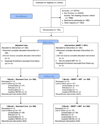Successful Tobacco Dependence Treatment in Low-Income Emergency Department Patients: A Randomized Trial
- PMID: 25920384
- PMCID: PMC4819432
- DOI: 10.1016/j.annemergmed.2015.03.030
Successful Tobacco Dependence Treatment in Low-Income Emergency Department Patients: A Randomized Trial
Abstract
Study objective: Tobacco use is common among emergency department (ED) patients, many of whom have low income. Our objective is to study the efficacy of an intervention incorporating motivational interviewing, nicotine replacement, and quitline referral for adult smokers in an ED.
Methods: This was a 2-arm randomized clinical trial conducted from October 2010 to December 2012 in a northeastern urban US ED with 90,000 visits per year. Eligible subjects were aged 18 years or older, smoked, and were self-pay or had Medicaid insurance. Intervention subjects received a motivational interview by a trained research assistant, 6 weeks' worth of nicotine patches and gum initiated in the ED, a faxed referral to the state smokers' quitline, a booster call, and a brochure. Control subjects received the brochure, which provided quitline information. The primary outcome was biochemically confirmed tobacco abstinence at 3 months. Secondary endpoints included quitline use.
Results: Of 778 enrolled subjects, 774 (99.5%) were alive at 3 months. The prevalence of biochemically confirmed abstinence was 12.2% (47/386) in the intervention arm versus 4.9% (19/388) in the control arm, for a difference in quit rates of 7.3% (95% confidence interval 3.2% to 11.5%). In multivariable logistic modeling controlling for age, sex, and race or ethnicity, study subjects remained more likely to be abstinent than controls (odds ratio 2.72; 95% confidence interval 1.55 to 4.75).
Conclusion: An intensive intervention improved tobacco abstinence rates in low-income ED smokers. Because approximately 20 million smokers, many of whom have low income, visit US EDs annually, these results suggest that ED-initiated treatment may be an effective technique to treat this group of smokers.
Copyright © 2015 American College of Emergency Physicians. Published by Elsevier Inc. All rights reserved.
Conflict of interest statement
The authors report no conflicts of interest.
Figures
Comment in
-
ACP Journal Club. In adult smokers in the ED, a multicomponent intervention increased smoking cessation at 3 months.Ann Intern Med. 2015 Oct 20;163(8):JC9. doi: 10.7326/ACPJC-2015-163-8-009. Ann Intern Med. 2015. PMID: 26502146 No abstract available.
References
-
- U.S. Department of Health and Human Services. U.S. Department of Health and Human Services CfDCaP. Atlanta, GA: National Center for Chronic Disease Prevention and Health Promotion, Office on Smoking and Health; 2014. The Health Consequences of Smoking--50 Years of Progress. A Report of the Surgeon General.
-
- Glauser J. Rationing and the role of the emergency department as society's safety net. Acad Emerg Med. 2001;8:1101–1106. - PubMed
-
- Gordon JA. Emergency care as safety net. Health Affairs. 2000;19:277. - PubMed
Publication types
MeSH terms
Grants and funding
LinkOut - more resources
Full Text Sources
Other Literature Sources
Miscellaneous


